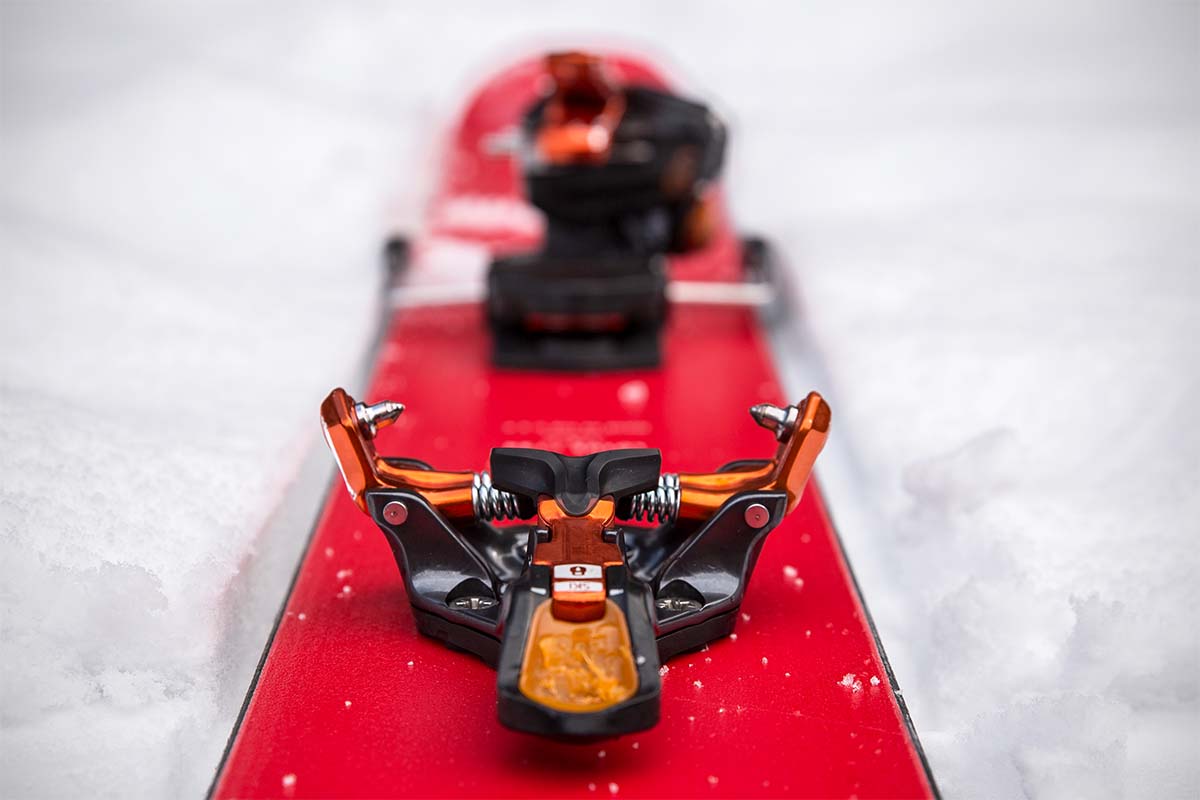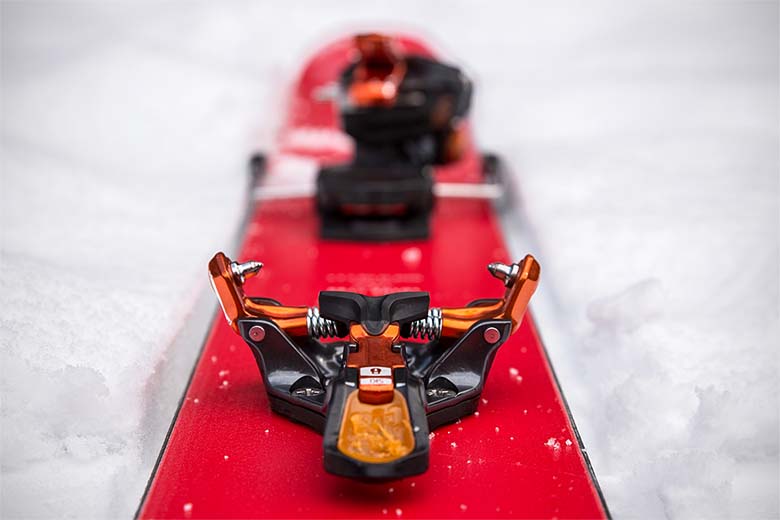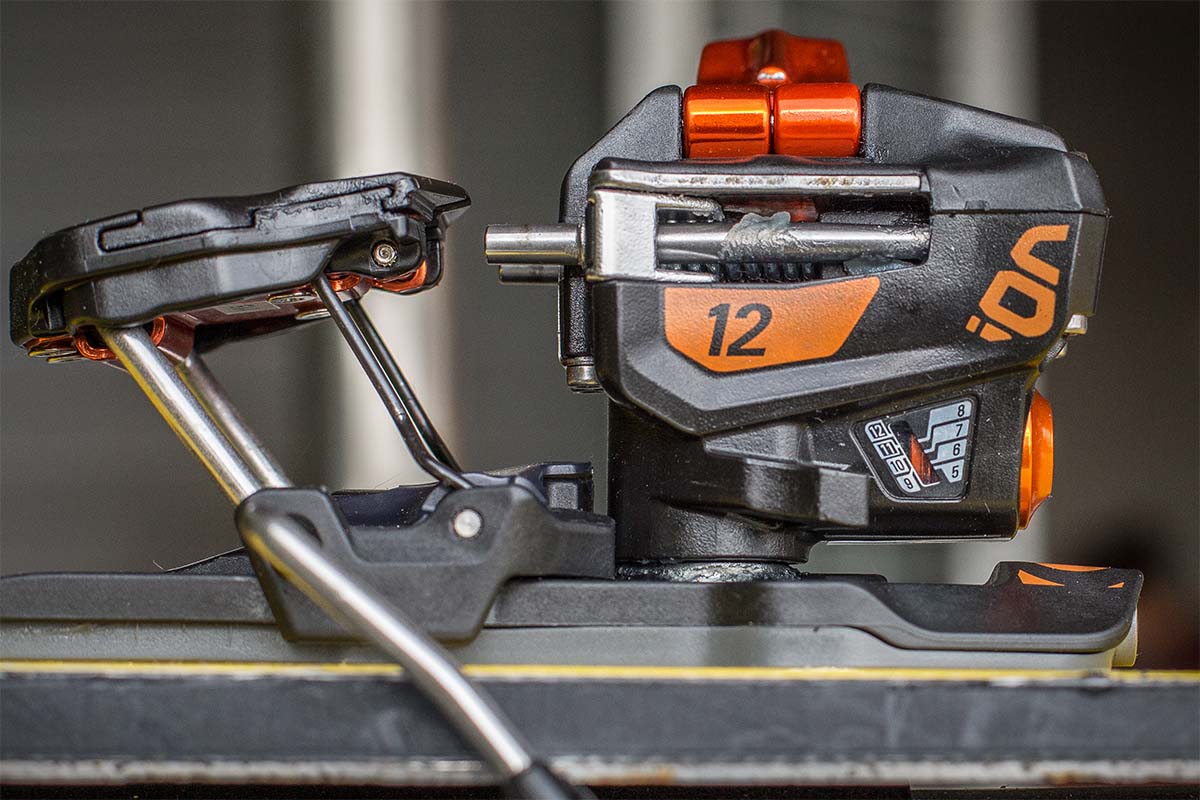

Price: $617
DIN: 5-12
Weight per pair: 2 lbs. 9.3 oz.
What we like: Versatile and reasonably light, great toe piece, and user-friendly.
What we don’t: Can’t match the resort performance of alternatives like the Salomon Shift.
See the G3 Ion 12
Now in its second generation, G3’s Ion has earned a solid reputation in the tech binding market for its user-friendly design. With a full season of testing under my belt with the 12-DIN model, I've found its auto-rotation lock, simplified step-in, and reasonable weight help make long days on the skin track very enjoyable. And while it feels a bit out-of-place in resort-like conditions, this binding truly excels on the descent in powder. Below are my experiences with the G3 Ion 12. To see how it stacks up to the competition, see our article on the best backcountry ski bindings.
The G3 Ion 12 binding weighs in at 2 pounds 9.3 ounces per pair, falling mid-pack in terms of weight in the touring market. But while it lacks the feathery feel of other bindings like the Salomon MTN Pure (1 lb. 12 oz.) and Dynafit TLT Speed (1 lb. 4.1 oz.), the Ion 12 makes up for it in the features department. With a secure, easy-to-clean toe piece, auto-rotation lock in the heel, and two large aluminum climbing aids that flip forward or back with a ski pole, I found the Ion 12 to be a trusty and straightforward uphill companion. Its standard three heel risers were easily adaptable to any pitch: near-flat at two degrees, mid-range at seven degrees (which I use for most climbs), and high at 14 degrees (reserved for the super steep stuff). And if icy, steep, and wind-crusted is your preferred terrain condition, the Ion 12 is compatible with G3 Ion crampons..jpg)
According to G3, the Ion 12 is 33 percent wider than other tech bindings, translating to more power transfer and responsiveness on wide skis. I’ve mounted the binding on skis with both 112- and 124-millimeter waists, and it has excelled in everything from deep Mount Baker powder to heavy and wet North Shore “snow”—and even in-bounds days in crummy conditions. That said, for resort skiers looking to dabble in the backcountry, this might not be the jack-of-all-trades binding you need. While the Ion 12 did well in powder, it was noticeably less stable in resort-like conditions on skied-out, firm snow. All things considered, the Ion 12 falls short of a one-quiver charger like the Marker Kingpin 13 or Salomon S/Lab Shift—if you’re willing to haul up another pound or so. .jpg)
G3 does offer a 10-DIN version, but the Ion 12 I tested is a nice match for aggressive skiers. As a traditionalist, I highly prefer setting a DIN number to using predetermined values like on that of the Salomon MTN, which only allows you to choose among women’s, men’s, and expert release values. While that might make it simpler for some, I rely on my DIN to keep me secure while skiing yet release exactly as expected. And I’ve had no early release issues with the Ion 12—it has released upon impact (as if on cue) each and every time. One thing to note, though: the toe piece spring can ice up, causing it to disengage at inopportune times. Be sure to clear it of snow and ice buildup periodically. 
The current G3 Ion 12 boasts improvements that make transitioning more efficient. While not as intuitive as alpine-heeled bindings like the Salomon S/Lab Shift or Marker Kingpin 13, adapting to the system didn’t take long, and transitioning between modes quickly became seamless. Switching from walk to ski mode requires pressing the toe piece lever down to the “ski” position (it still keeps the pins in the boot but unlocks them and allows the binding to release as intended if you take a fall). You can then pull the heel piece to disengage the auto-rotation lock and pivot it so that the pins face forward, stepping down to snap into the binding. While I’ve found that the heel piece rotates easily in either direction, some have reported it being so difficult to turn that they have to remove their skis. Thankfully, I haven’t had that happen yet. To transition back to walk mode: click out, rotate the heel, press your boot into the bumper to guide your foot into the toe piece, and step down to disengage the brakes. .jpg)
At 2 pounds 9.3 ounces, the Ion 12 isn’t the lightest tech binding on the market, nor is it the heaviest. Options in the same weight class include the Dynafit ST Rotation (2 lbs. 10.7 oz.) and Fritschi Tecton 12 (2 lbs. 12.4 oz.), both of which give the Ion 12 a run for its money performance-wise but don’t quite match the ease of use. And although almost a pound heavier than the Salomon MTN Pure (1 lb. 12 oz.), the Ion 12 is a moderately better and more versatile all-rounder, especially given its DIN range and downhill ability. I consider the Ion 12 light enough for hours on the skin track but burly enough to provide power and instill confidence on the way down. If weight is a major concern, check out G3’s own Zed 12—a lighter, brakeless alternative that checks in a full pound lighter than the Ion at 1 pound 9.3 ounces..jpg)
Despite the undeniable craftsmanship of the Ion 12, it’s worth outlining two major durability issues I experienced (as well as a recall a few years ago that affected the front heel body screws on some Ion 12s). To provide some context: both my wife and I used the Ion (both the 10 and 12 models) for several years with no issues—until the 2017-2018 season, when my bindings suffered some mechanical defects. Thankfully, neither issue rendered the bindings useless (a blessing, since I do 95 percent of my skiing far from civilization or a ski shop).
The first issue was as follows: I was skinning over a depressed area in the skin track, which caused the ski to flex and the boot sole length (BSL) to shorten as myf foot came down. When my ski crested the depression, the BSL re-lengthened and the edge of my boot caught the lip of the heel, snapping it off under the pressure. This rendered the climbing aids tensionless, flopping around with every step I took in walk mode. And the second issue: One of the brake arms torqued under pressure and bent, causing the plastic mold that holds it in place to snap off. This left one brake arm dangling around uselessly, on the verge of falling off..jpg)
To be fair, this isn’t the first set of bindings I’ve had problems with. Based on my research, these issues with the Ion 12 appear to be anomalies, but backcountry-goers should always weigh durability heavily. You often end up—as I did—far from your destination when things go wrong. That said, backcountry ski gear endures rough handling pretty much the entire time it’s in use. And it goes somewhat without saying that quality is earned, meaning companies like G3 that have been making bindings and backcountry gear for years have rightfully gained trust among skiers worldwide. My point? I re-ordered the Ion 12 and haven’t hesitated to take it out on many more touring adventures since.
We tested the 12-DIN variation of the Ion binding for this review, and G3 also offers a 10-DIN model. Compared to the Ion 12, the Ion 10 costs $44 less at $573 and has a release value range of 4 to 10 (compared to the Ion 12’s 5-12 range). As we touched on above, the Ion 10 is a serviceable alternative for lighter and less aggressive skiers, although heavier and more powerful riders will likely prefer the 12 for the added security on rowdy descents and at speed..jpg)
.jpg)
| Binding | Price | Type | Release | Weight | Brake Sizes |
|---|---|---|---|---|---|
| G3 Ion 12 | $617 | Tech | 5-12 | 2 lbs. 9.3 oz. | 85, 100, 115, 130mm |
| Salomon MTN Pure | $550 | Tech | 3 settings | 1 lb. 12 oz. | 80, 90, 100, 110, 120mm |
| Marker Kingpin 13 | $650 | Tech | 6-13 | 3 lbs. 0.7 oz. | 75-100, 100-125mm |
| Marker Alpinist 12 | $450 | Tech | 6-12 | 1 lb. 1.3 oz. | 90, 105, 115mm |
| Salomon S/Lab Shift MNC | $600 | Tech | 6-13 | 3 lbs. 14.4 oz. | 90, 100, 110, 120mm |
| G3 Zed 12 | $499 | Tech | 5-12 | 1 lb. 9.3 oz. | 85, 100, 115, 130mm |
The tech binding market isn’t short on options, and another model that we tested alongside the G3 is the Salomon MTN Pure. Comparing the two, the MTN has a superior weight-to-performance ratio (it comes in at a scant 1 lb. 12 oz.), but the heavier Ion 12 (2 lbs. 9.3 oz.) is more of a downhill charger. In terms of features, the MTN’s step-in aid performed similarly to the Ion 12’s BootStop—both additions made the toe pins easy to line up and step into, and also made transitions a breeze. We do prefer the MTN’s heel for its ability to tour in ski mode on short ascents, but the lack of a DIN setting doesn’t instill the same confidence on the way down. If you’re looking for an ultralight set-up for long tours, the MTN is a solid choice. But if you’re willing to sacrifice ounces for more stability on the descent, we give the nod to the G3 Ion. .jpg)
Speaking of descents, the Marker Kingpin 13 has proven to be a trustier companion than the G3 Ion 12 in resort-like conditions. Specifically, the Ion 12 was noticeably less steady when moving quickly over skied-out, firmer snow. This is partially due to the Kingpin’s full alpine heel, which provides the secure feeling of an alpine binding without the weight. In powder, however, we found that the Ion 12 was similarly confidence-inspiring, even on wider skis. And at around half a pound lighter per pair, it was an obvious choice for multi-day tours. For downhill performance in the backcountry, the Kingpin 13 fared better, but given the Ion 12’s lightweight construction, we think it offers a bit more versatility when taking both the uphill and downhill into account.
For a lighter-weight option from Marker, their newer Alpinist 12 has a lot of appeal for experienced backcountry riders. Stacked up against the Ion, the Alpinist is considerably lighter at 1 pound 1.3 ounces (1 lb. 7.6 oz. with brakes) but boasts a similar “gapless” (also known as “kiss gap”) heel piece that moves along a track and promotes a more consistent release and smoother rider than a model like the MTN Pure above. The heavier Ion 12 wins out in durability and power and stability on the descent, making it the more reliable pick for particularly aggressive riders and big, committing lines. But for a considerable $167 cheaper (adding brakes narrows the price gap to $108), the Alpinist offers an excellent balance of weight and downhill capabilities and is an enticing alternative for confident and weight-conscious riders..jpg) For maximum versatility, it’s an easy call: the Salomon S/Lab Shift MNC wins out (there’s also an identical model from Atomic). Similar to the Kingpin 13, the Shift excels on descents due to its alpine heel. But add in its toe piece—which functions like a pin set-up for the uphill but converts to a traditional downhill toe in ski mode—and you’ve got the best of both worlds. All in all, the Shift has proven to be noticeably more confident on descents. That said, the two-mode toe piece and beefy heel do add some weight, so ultralighters likely will prefer the Ion 12 for less heft on the skin track. But if you’re looking for a one-quiver binding that you can use with your both your downhill and touring set-ups, the Shift takes the cake.
For maximum versatility, it’s an easy call: the Salomon S/Lab Shift MNC wins out (there’s also an identical model from Atomic). Similar to the Kingpin 13, the Shift excels on descents due to its alpine heel. But add in its toe piece—which functions like a pin set-up for the uphill but converts to a traditional downhill toe in ski mode—and you’ve got the best of both worlds. All in all, the Shift has proven to be noticeably more confident on descents. That said, the two-mode toe piece and beefy heel do add some weight, so ultralighters likely will prefer the Ion 12 for less heft on the skin track. But if you’re looking for a one-quiver binding that you can use with your both your downhill and touring set-ups, the Shift takes the cake.
The final competitor we’ll cover is G3’s own Zed binding. Released after the Ion, the Zed shares a lot of its features—the easy step-in, smooth transitions, and heel lifters—but in a trimmed-down build. Weighing in at 1 pound 9.3 ounces, the 12-DIN model is a full pound lighter than the Ion for the pair, which certainly makes a difference for extended tours or those wanting to cover ground quickly. The tradeoff is a harsher ride through variable terrain, plus you inevitably make compromises in long-term durability by cutting that much weight. We prefer the stronger and easier-to-trust performance of the Ion, which is why we give it the advantage in our ski binding round-up.
If you’re thinking about buying gear that we’ve reviewed on Switchback Travel, you can help support us in the process. Just click on any of the seller links above, and if you make a purchase, we receive a small percentage of the transaction. The cost of the product is the same to you but this helps us continue to test and write about outdoor gear. Thanks and we appreciate your support!
Depending on the seller, most products ship free in the United States on orders of $50 or more. International shipping availability and rates vary by seller. The pricing information on this page is updated hourly but we are not responsible for inaccuracies.